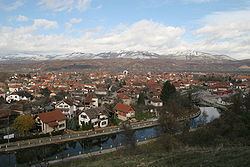Settlements 46 Postal code 18310 Local time Thursday 3:39 AM | Time zone CET (UTC+1) Area 551 km² | |
 | ||
Weather 5°C, Wind W at 13 km/h, 86% Humidity | ||
Serbia beautiful bela palanka by slavisa sokolovic
Bela Palanka (Serbian Cyrillic: Бела Паланка, [bɛ̂ːlaː pǎlaːŋka]) is a town and municipality located in the Pirot District of the eastern Serbia. According to the 2011 census, the population of the town is 8,112, and the population of the municipality is 12,051. In ancient times, the town was known as Remesiana. The name Bela Palanka means 'white town'.
Contents
- Serbia beautiful bela palanka by slavisa sokolovic
- Map of Bela Palanka Serbia
- Geography
- Demographics
- History
- References
Map of Bela Palanka, Serbia
Geography
Bela Palanka is a small town in the southeast of the country and is surrounded by countryside and mountains. The town is accessible from the nearby city of Niš by the Niš Express buses that run from Niš to Pirot, Babušnica, Dimitrovgrad, and Sofia.
Demographics
Ethnic groups in the municipality (2002 census):
History
The town was originally settled by the Dacians and was known under the ancient name of Aiadava or Aeadaba. Thracians inhabited the area until their assimilation into contemporary ethnic groups in the area.
After the Romans conquered Moesia in 75 BC, the new castrum (imperial domain with estates) and municipium was known initially as Ulpianorum and then Remesiana (Moesi) and stood along the Via Militaris between Naissus and Serdica.
Emperor Justinian had following strongholds in the district of Remesiana:
The patron saint of Romania, Nicetas of Remesiana, was a 4th-century bishop at Remesiana. Peter the Hermit was defeated by the Byzantines in the north and regrouped at an evacuated Bela Palanka, gathering the harvest before heading to Constantinople.
Excavations include well-preserved castrum dating to 4th century and a hoard of 260 coins minted during the rule of Constantine I, Theodosius I, Tiberius Claudius Nero (3rd century AD).
From 1929 to 1941, Bela Palanka was part of the Morava Banovina of the Kingdom of Yugoslavia.
